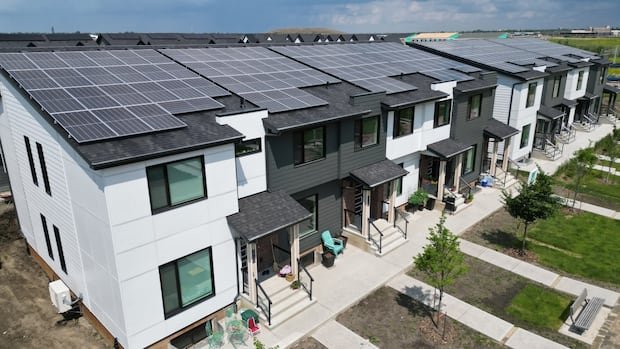In Edmonton’s new Blatchford neighborhood, Rebecca Calder’s residence remains unaffected by local power outages. Equipped with a backup battery in the basement, essential appliances like Wi-Fi, the refrigerator, and the heat pump continue to function seamlessly.
The battery, charged by solar panels on the roof of their three-bedroom home, allows the Calder family to utilize stored solar power even after sunset. This setup not only benefits the Calders but also contributes to the local electrical grid by being part of a virtual power plant. This virtual power plant combines the resources of 100 homes to supply power to the grid, akin to a physical power plant.
Rebecca Calder expressed satisfaction with the setup, highlighting the joy of seeing their power contributions reflected in the electricity bill credits. Virtual power plants play a crucial role in integrating more renewable energy sources like wind and solar into the grid, ensuring stability and potentially reducing the need for costly infrastructure upgrades.
Virtual power plants consist of interconnected devices such as smart thermostats, electric vehicle batteries, and solar panels with storage capabilities. While most virtual power plants in Canada primarily involve smart thermostats for demand management, the Blatchford project goes a step further by actively generating and deploying electricity like traditional power plants.
During the summer, surplus energy generated by solar panels is stored in the battery, managed by local utilities EPCOR and Solartility. The utilities can access the stored energy to stabilize the grid or capitalize on high electricity prices. Homeowners like Calder can monitor but not control the system, ensuring a seamless and efficient operation.
Embracing renewable energy, Rebecca Calder believes her family is making a significant contribution to combatting the climate crisis. The system ensures a reliable backup power source during outages while also enabling the sale of excess power to the grid. The integration of these systems into virtual power plants offers financial benefits to homeowners while supporting grid stability.
Looking ahead, the Blatchford virtual power plant is set to expand to include more homes, maximizing energy storage capacity and deployment capabilities. Such initiatives pave the way for larger-scale projects that can revolutionize energy generation and distribution, much like successful models in Europe and the United States.
As the virtual power plant model gains momentum, regulatory frameworks in Canada are evolving to accommodate distributed energy sources. Provinces like Alberta are beginning to allow individual homes to contribute power to the grid through aggregators, fostering a more sustainable and resilient energy ecosystem.
Overall, Rebecca Calder encourages other families to consider similar energy solutions, emphasizing the empowerment of producing, utilizing, saving, and sharing power within the community.


